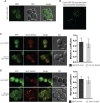Cex1 is a component of the COPI intracellular trafficking machinery
- PMID: 33753324
- PMCID: PMC8015235
- DOI: 10.1242/bio.058528
Cex1 is a component of the COPI intracellular trafficking machinery
Abstract
COPI (coatomer complex I) coated vesicles are involved in Golgi-to-ER and intra-Golgi trafficking pathways, and mediate retrieval of ER resident proteins. Functions and components of the COPI-mediated trafficking pathways, beyond the canonical set of Sec/Arf proteins, are constantly increasing in number and complexity. In mammalian cells, GORAB, SCYL1 and SCYL3 proteins regulate Golgi morphology and protein glycosylation in concert with the COPI machinery. Here, we show that Cex1, homologous to the mammalian SCYL proteins, is a component of the yeast COPI machinery, by interacting with Sec27, Sec28 and Sec33 (Ret1/Cop1) proteins of the COPI coat. Cex1 was initially reported to mediate channeling of aminoacylated tRNA outside of the nucleus. Our data show that Cex1 localizes at membrane compartments, on structures positive for the Sec33 α-COP subunit. Moreover, the Wbp1 protein required for N-glycosylation and interacting via its di-lysine motif with the Sec27 β'-COP subunit is mis-targeted in cex1Δ deletion mutant cells. Our data point to the possibility of developing Cex1 yeast-based models to study neurodegenerative disorders linked to pathogenic mutations of its human homologue SCYL1.
Keywords: Arc1; COPI coat; Cex1; SCYL1; Trafficking.
© 2021. Published by The Company of Biologists Ltd.
Conflict of interest statement
Competing interestsThe authors declare no competing or financial interests.
Figures




References
-
- Blondeau, F., Ritter, B., Allaire, P. D., Wasiak, S., Girard, M., Hussain, N. K., Angers, A., Legendre-Guillemin, V., Roy, L., Boismenu, D.et al. (2004). Tandem MS analysis of brain clathrin-coated vesicles reveals their critical involvement in synaptic vesicle recycling. Proc. Natl Acad. Sci. USA 101, 3833-3838. 10.1073/pnas.0308186101 - DOI - PMC - PubMed
-
- Burman, J. L., Bourbonniere, L., Philie, J., Stroh, T., Dejgaard, S. Y., Presley, J. F. and McPherson, P. S. (2008). Scyl1, mutated in a recessive form of spinocerebellar neurodegeneration, regulates COPI-mediated retrograde traffic. J. Biol. Chem. 283, 22774-22786. 10.1074/jbc.M801869200 - DOI - PubMed
Publication types
MeSH terms
Substances
LinkOut - more resources
Full Text Sources
Other Literature Sources
Molecular Biology Databases

